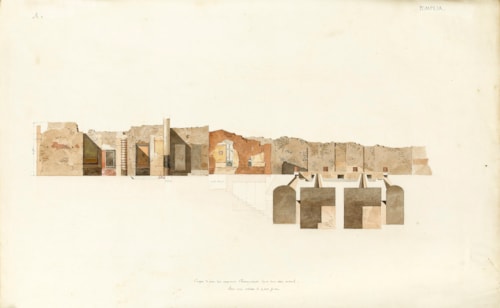
Jacques Félix DUBAN
Paris 1798 - Bordeaux 1870
Biography
Félix Duban entered the Ecole des Beaux-Arts in Paris in 1814, and in 1823 won the Grand Prix de Rome in the category of architecture. He spent the next five years as a pensionnaire at the Académie de France at the Villa Medici in Rome. Soon after his arrival in Rome he visited Pompeii with his friend, the architect Henri Labrouste, and there seems to have been particularly interested in the houses which had been discovered at the beginning of the 19th century. He produced plans and drawings of several of these, as well as of temples, theatres and baths. Duban was also particularly influenced by the polychrome wall paintings of Pompeii, as can be seen in his approach towards interior decoration in his later career.
On his return to Paris, he exhibited elaborate architectural drawings at the Salons of 1830, 1831 and 1833, although he does not seem to have exhibited there in later years. Nevertheless, he enjoyed a successful career as an architect, with perhaps his best known work the main buildings and courtyard of the Ecole des Beaux-Arts in Paris, begun in 1830 but not completed until some thirty years later. Duban also worked on the restoration of the Sainte-Chapelle in Paris between 1839 and 1849 and the Galerie d’Apollon at the Louvre, begun in 1848, as well as the chateaux of Dampierre, Gaillon and Blois. In 1854 he was elected to the Institut and appointed inspector-general of public works.
Duban was a gifted draughtsman, and produced a large body of drawings and watercolours of superb quality. These included not only studies of ancient, medieval and Renaissance buildings in Italy and France, but also imaginative reconstructions of how these buildings once looked, with subjects such as A Room in a Classical Villa, The Cella of the Parthenon with the Statue of Phidias and A Street in Pompeii. He also received private commissions for his drawings, such as a portfolio of Views of Several Paris Monuments Completed During the Reign of Louis-Phillippe, executed in 1837 for the Duc d’Orléans. As has been noted, ‘His draughtsmanship is of exemplary quality and goes far beyond the realm of simple architectural drawing…The vacuum left by Duban in terms of theoretical writing seems largely filled by his body of drawings. He was, in every sense, a complete artist - an embodiment of his own ideal as reflected in his achievements at the Beaux-Arts and the Chateau de Blois.’ In 1872, two years after Duban’s death, a retrospective exhibition of his architectural drawings and watercolours was held at the Ecole des Beaux-Arts, to considerable critical acclaim.


